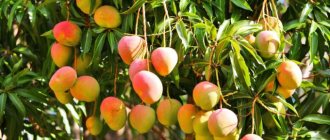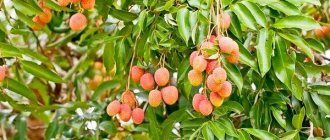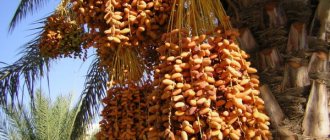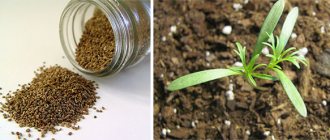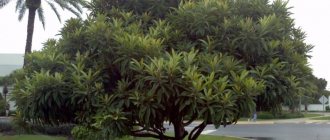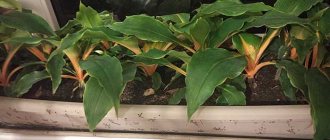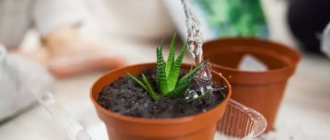Tangerines are an indisputable attribute and harbinger of the New Year. Citrus notes flow through the apartments in a magical trail, lifting the mood and bringing a sense of celebration even to the dullest day. Do you want aroma to excite you all year round? All you need is a few seeds, a pot of soil and a little persistence. How to grow tangerines at home, what to feed and when to plant? Consulting agronomist Vasily Opimakh, especially for AGRONEWS, broke down all the subtleties of the new trend - exotics on the windowsill.
Bury in the ground
It is better to select seeds for planting from real, non-hybrid tangerines. This way there is a greater chance of seeing fruit on the tree even without grafting.
— It can be difficult for amateurs to distinguish a hybrid tangerine. I advise you to stick to Abkhazian fruits. Seedlings from such “parents” will be more resistant to unfavorable conditions.
You need to plant the seeds as soon as you eat the tangerine. But even if they are dry, it’s not scary. Place the seeds in damp gauze for several days, and when the sprouts hatch, place them in the ground.
Plant nutrition
To obtain fruits you need a special approach to fertilization. As the tree matures, you need to start feeding it. Mandarin grows quickly and needs to be fed from spring to autumn. In winter, fertilizing is not required. It is best to use special fertilizers for citrus fruits; you can also use an infusion of mullein or chicken droppings. It is best to alternate fertilizing, and fertilize strictly according to the instructions, since an excess of fertilizers is also harmful.
The main thing is that the pot sits
When choosing land for planting, remember that tangerines do not tolerate acidic soil. The substrate can be purchased at the store. On the packaging, look for the mark pH = 6.5–7 (neutral soil). Or assemble the composition yourself, according to our expert’s recipe:
- Mix two parts humus, two parts field soil and one part sifted river sand. Even plastic cups are suitable as the first pot, but be sure to have a drainage hole. Excessive watering is dangerous - there is a risk that the sprouts will rot and die. The seeds are planted to a depth of about 1.5–2 cm. The optimal temperature for such crops is 20–25 ºC. If the room is cool, the germination period is delayed. If you follow all the recommendations, you will see results in three to four weeks.
For normal growth, seedlings need diffused light. It is better to place pots of tangerines in a room with windows facing south.
Planting tangerine seeds
Planting tangerine seeds is carried out as follows:
- Fill the seedling cups (or bowl) with loose and nutritious soil so that there is about 2 cm of free space left to the top edge.
- Using a stick (or a simple pencil), make small indentations (about 2-2.5 cm).
- Place one tangerine seed in each hole. If the seed has already sprouted, then it needs to be lowered with the sprout down, because it is a root.
- Water the soil thoroughly.
Cover the cups or a common bowl with a plastic bag or glass to provide the seeds with high air humidity and stable heat. If you don't cover your plantings, the seeds will still germinate, but it may take longer. Place the containers on a well-lit windowsill.
Replant it immediately
During the growing process, some seedlings may die. But natural selection will allow you to get strong shoots.
— After the seedlings grow up, they need to be replanted. Choose a new pot with a diameter 2–3 cm larger than the previous one. This way the plants evenly form the required ratio of above-ground and root mass. For young trees, the flowerpot is changed once a year. Those that already bear fruit no more than once every 2-3 years and only after harvesting.
Growing a fruiting tree: grafting rules
In nature, a tangerine grown from a seed bears fruit in about 5 years, but it will be wild with tasteless fruits. Grafting a tangerine will speed up fruiting and give you the opportunity to get full-fledged tasty fruits. The plant needs to be grafted in April, early May or August, when sap flow is especially active. In other months it is unlikely to achieve success.
A positive result directly depends on how quickly and accurately you perform all the manipulations.
Before you start grafting your tangerine tree, prepare the following:
- rootstock, that is, a plant that you grew from a seed, with a trunk thickness of about 6 mm;
- scion - a fresh eye or cutting taken from a fruiting tangerine from a branch up to 2 years old;
- budding garden knife;
- elastic tape;
- garden var.
On the trunk of the rootstock at a height of 10 cm, make a cut in the shape of the letter “T”: horizontally 1 cm, vertically 2–4 cm.
Prepare the scion: remove thorns and leaf blades. Carefully cut the bud with a small layer of wood and insert it into the cut.
Tangerine budding scheme
Carefully wrap the tape around the area where the “operation” was performed.
After grafting, place the plant under a jar or plastic bag. This way you will create the necessary microclimate and humidity.
Not earlier than in a month you will be able to see whether the vaccination was successful or not. This is why you will need several copies of tangerine seedlings so that at least a couple of them are grafted successfully.
As soon as you see that the grafted bud has sprouted, begin to accustom the sprout to the air outside the jar. Gradually increase the ventilation time and eventually remove the winding. After another month, when the new shoot has strengthened and is growing well, carefully cut off the trunk of the rootstock diagonally 3 mm above the base of the shoot. Cover the cut area with garden varnish.
Place a stick in the pot on which to fix the tree so that it grows vertically. After this, do not forget to water, feed and spray your tangerine.
Beauty requires sacrifice
An important stage in growing citrus fruits is crown formation. The tangerine tree is pruned to speed up fruiting. Vasily Opimakh explains that if a seedling at a height of 30–40 cm flatly refuses to branch, the top should be pinched:
— This manipulation will force the plant to send out lateral branches. But this is not enough for flowering - it bears fruit only on branches of the 4th–5th order. To force the tree to share its harvest, the tips of the shoots are cut off behind the fourth leaf and weak branches are removed. Crown formation takes about 3–4 years.
Possible problems with seedlings
During the growth and care of the plant, some unforeseen troubles may appear, such as yellowing of the leaves. Perhaps the tangerine is shedding aged foliage or signaling for help. It is worth taking a closer look at your “pet” and determining the reason for its elimination.
Possible reasons:
- If your tree is many years old, but it looks healthy, then the cause of yellowing is getting rid of old, unnecessary leaves.
- When the crown completely acquires a lighter shade, the reason lies in the lack of light. Then it is necessary to move the plant to a sunnier place or, if it is impossible, to supply artificial light.
- Too dry air, draft or very deep planting of rhizomes can cause the leaves to drop. In this case, eliminating the cause will correct the situation.
- If the leaf begins to dry out at the tip and falls off, this indicates that the soil is over-moistened or the container is too large. To eliminate the problem, you need to transplant the plant into a container of suitable size, cut off the rotten roots, prepare the soil (loosen the new soil).
- When the greens begin to turn yellow from the bottom of the tree and continue to move to the top, the tangerine needs to be fertilized with a nitrogen-containing product. This behavior indicates a lack of this substance.
- The yellow color of the shoots, extending onto the old leaves, indicates a lack of iron.
- If none of the signs are detected, but the tree loses its leaves, then the plant lacks potassium. In this case, potassium nitrate will help.
Take part in water procedures
The tangerine tree loves moisture. The expert advises watering the plant 2–4 times a week, and only with settled water at room temperature.
— It’s easy to check whether the soil is dry: take a pinch of soil; if it crumbles in your hands and does not form a lump, it’s time to take a watering can. By the way, tangerines generally love humidity. Don't be lazy to spray them. In summer, such manipulations should be carried out 2–4 per day. If the tree is blooming, you need to work with the spray bottle very carefully - under no circumstances should water get on the buds.
Loves tangerine and sunshine. However, make sure that direct rays do not burn the leaves. To ensure uniform growth of the crown, the pot is rotated around its axis.
— The optimal rotation mode is once every 2 weeks by no more than 10 degrees. It is also important to observe the temperature regime. For an adult tangerine tree, the norm is from 15 to 18 degrees with a plus sign. In summer, the room should not be hotter than +30. If the tree has bloomed, the norm for the thermometer is +20-25, otherwise the buds will fall off.
Errors when leaving
Often tangerines do not have enough nitrogen fertilizers, so their leaves lose their rich color. At the beginning of spring you need to feed with nitrogen fertilizers. Nitrogen deficiency can be replenished with fertilizers such as ammonium nitrate and ammonium sulfate.
Dry air can also cause poor seedling development. A container of water will help restore air humidity. Poor lighting is another maintenance mistake. During short daylight hours, tangerines need to be illuminated.
A small or too large pot also creates discomfort for the tangerine.
A common mistake when growing is improper preparation for winter. If the leaves begin to wither, then you need to stop feeding and water abundantly. The seedling must be moved to a semi-dark and cool place so that it enters the dormant stage.
Shock therapy
Often gardeners are faced with a problem: the tangerine tree has grown, but flatly refuses to bear fruit. Shock therapy will help bring him out of suspended animation.
— Change the microclimate in winter and take the plant out of its comfort zone. The air temperature should be lowered to +12 ˚С, watering should be reduced, but the soil should not be allowed to dry out. In spring, when the temperature rises to +15-18 ˚С, there is a chance that the tangerine will bloom.
Vegetable garden on the windowsill: soon in all apartments in the country! What problems do we face when growing pepper seedlings? Consulting agronomist Vasily Opimakh knows about this.
Difficulties arise already at the stage of seed selection and pre-sowing treatment. How to properly disinfect seeds, is it worth germinating and replanting them? Read the material.
Where to get planting material
The easiest way to grow a tangerine tree is to buy seedlings. Most often, such specimens are already grafted, and the harvest appears in the second or third year.
You can also use a method like growing a tangerine from a seed. To get planting material, we go to the supermarket and look for healthy, not rotten, not moldy, strong fruit. It is recommended to plant at least 15 seeds. Then you will definitely be able to achieve the desired result. Of the tangerine sprouts that appear, only the strongest will need to be left and the others removed.
Grafting tangerines
The tree will produce its first fruits in 5-6 years. But there is a nuance. In taste, aroma and size, they can differ significantly from their ancestor. In order to reap a good harvest in the future, he needs a grafting of a cutting from a varietal tangerine.
— Such surgical manipulations should be carried out during the period of sap flow and only on a plant whose trunk is no smaller in diameter than a pencil. At a height of 5-10 cm, you need to make a T-shaped cut on the tangerine bark. This place should be smooth, without knots, swelling or roughness. The length of the horizontal line is about 1 cm, and the vertical line is 3 cm. We bend the ends, insert the scion (as in a pocket, inserting the shield from top to bottom) and press the bark. We treat the joint with garden varnish and wrap it with electrical tape.
If the tangerine grafting is successful, the bud will take root within three weeks, the petiole of the leaf will turn yellow and easily fall off. If the “operation” fails, on the contrary, it will turn black.
Choosing the best capacity
To have a beautiful and healthy citrus plant on your windowsill that will bear fruit or simply delight you with its appearance, you need to choose the right container.
Some gardeners practice growing tangerine seedlings in disposable cups. This is possible, but experts still advise choosing peat or flower pots, since in a glass the process of water evaporation occurs more slowly, which is harmful for the growth and development of the future tree. Hatched seeds can be grown in a regular box intended for seedlings. If the gardener still decides to buy a pot for him, it is better to choose a small one.
Uninvited guests. How to save a tangerine tree from pests?
Citrus pets at home can also get sick and even die from pests. One of the main “enemies” of the tangerine is the spider mite. Thin threads and light dots on the back of the sheet will give you a signal.
— To get rid of a dangerous insect, you need to thoroughly wash the greens with warm water and laundry soap and spray with an insecticide. The scale insect may also fall out of the blue. It is easy to calculate: by the sticky coating on the leaves. The folk method of fighting is a soap solution with kerosene: for 1 liter of water, 5 g of soap and 10 g of kerosene. Spray up to twice a week or use insecticides.
Planting and growing exotic plants on a windowsill is not so difficult. The main thing is to be patient and strictly follow all recommendations. Then the tangerine tree will delight you with citrus aromas all year round.
And if you have questions or want to suggest a topic for material, write to us at
Diseases and pests
In addition to drying out or waterlogging the soil, pests can destroy the plant. If they are detected, immediate action must be taken.
The following types of tangerine pests include:
- Shield. A sign of its appearance is the presence of plates measuring 3-4 millimeters. The most effective in the fight against this parasite is treating foliage with insecticides Aktara, Fitoverm three to five times with an interval of 15 days or others, which can always be found on sale. But after such treatment, it is necessary to change the top layer of soil in the pot and stop eating the fruits.
- Aphid. These are green midges, the appearance of which is always noticeable. The leaves of the tree begin to curl, which indicates a loss of moisture in them. You can fight it with a solution of laundry soap, washing the leaves. Spraying with garlic tincture at the rate of one clove of garlic per glass of water (infuse for two days) and tobacco tincture - 40 grams of tobacco per liter of water can help. Such manipulations must be repeated after five to seven days.
- Spider mite. It is very small, but can be identified by small white dots on the bottom of the leaves and the presence of a thin web on the plant. Having discovered it, you need to wash the plant under running water using laundry soap. Afterwards, the plant should be sprayed several times with insecticides at intervals of seven to ten days.
- Mealybug. It is easy to detect - this parasite looks like white fluffy lumps. Unlike others, you can try to remove it with your hands, collecting each one separately. Insecticides are also suitable, or you can take 2 cloves of garlic, soap, pour half a liter of boiling water, leave for four hours and spray the bush.
Mealybug
Shchitovka
Aphids in magnification
Spider mite
